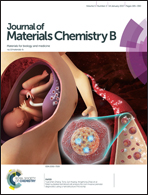Dispersed single wall carbon nanotubes do not impact mitochondria structure or function, but technical issues during analysis could yield incorrect results†
Abstract
Mitochondria are the organelles of cells that generate a majority of the cell's energy through ATP and are involved in programmed cell death through apoptosis. An understanding of non-specific targeting of nanomaterials, including single wall carbon nanotubes (SWCNTs), to organelles is important in trying to modulate cell function or determine the cellular toxicity with long term exposure. Here, we examine the impact of SWCNTs dispersed with Pluronic F127 and protein on mitochondria using a battery of standard tests. Seahorse XF24 analysis suggests complete loss of mitochondiral function, but this data is artifactual due to SWCNTs adsorbing onto the Seahorse probes. Imaging using the mitochondrial functional dye JC-1 gives inconclusive results owing to fluorescence quenching by SWCNTs. We observe no co-localization or reorganization of mitochondria in the presence of SWCNTs, although the results could have been misinterpreted had we not been correcting for significant fluorescence quenching by SWCNTs. In sum, the surface activity and fluorescence quenching of SWCNTs alter many traditional cellular assays. However, light emitting (luciferase) assays show that ATP levels are not altered with SWCNT treatment suggesting that mitochondiral function is not impacted as well as that light-emitting assays are an essential complimentary approach for quantitative, unambiguous cellular study of nanomaterials.



 Please wait while we load your content...
Please wait while we load your content...